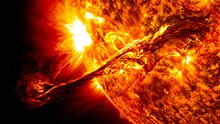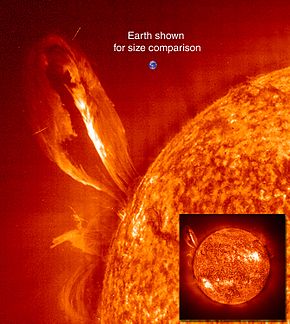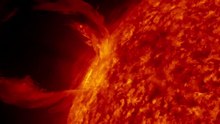Protuberance
Prominences are violent material streams on the sun , which at the edge of the sun can be observed as bright satin bows. They can also occur in smaller dimensions within the solar disk and can be observed in the red H-alpha light. If they appear here as dark , thread-like structures, they are called filaments .
Often protuberances are a few hundred thousand kilometers in length, 40,000 km in height and 5000 km in thickness (for comparison: the earth has a diameter of 12,700 km). Particularly strong currents can also rise over a million kilometers above the surface of the sun , whereby the arc can take off and hurl matter into space .
species
There are two types of prominences.

Resting protuberance
Dormant protuberances are structures whose shape often hardly changes for months. Often found near sunspots , they are created and held in shape by strong magnetic fields . Matter flows along the magnetic field lines above the sun's surface. It cools down and appears darker than the surroundings. If the magnetic fields are disturbed, the material falls back onto the surface. The luminous phenomena that occur are also called Hyder Flares .
Eruptive prominence

Eruptive protuberances (also called active protuberances , coronal mass ejections, or solar flares ) are phenomena that last only a few minutes or hours. Here, matter is hurled away from the sun at up to 1000 km / s. They sometimes arise from dormant protuberances, which usually resume their old form after ejection.
Emergence

The formation of a protuberance is based on magnetic reconnections in the sun's chromosphere . Magnetic field lines effectively wind their way out of the sun's complex magnetic field, pulling solar plasma with them.
The solar activity is extremely strongly correlated with the appearance of protuberances : similar to the sunspot cycle with a length of 11 or 22 years, a cyclical variability of the indicators over a period of several years can also be observed with protuberances. Particularly strong solar protuberances occur about every 11 years. During this time, polar lights can be seen more frequently than usual in the polar regions of the world .
observation
Since the luminosity of protuberances is much weaker than that of the photosphere , they can best be observed during a total solar eclipse . They then appear as large arches that protrude far into space.
Since devices that create a kind of artificial solar eclipse were invented a few decades ago, it has been possible to observe and measure protuberances at any time outside of solar eclipses. Examples of such devices are:
- Coronograph
- Protuberance spectroscope
- Spectroheliograph for measuring different levels of sunshine (as a special scanner technology)
- Protuberance attachment and telescope
- H-alpha telescope with an interference filter that only lets through the light of the ionized hydrogen .

